文章目录
前言
Netty为了减少频繁new对象的性能损耗,引进了一个通用的对象池,它就是Recycler。
在前面讲bytebuf的时候的时候就遇到过。不过它可不仅仅可以存bytebuf,用户也可以用来构造属于自己的对象池,这一节就来看看如何使用Recycler。
另外,因为Recycler是基于FastThreadLocal实现的,所以下面遇到诸如FastThreadLocal#get等方法将不再赘述,想知道详情的请看上一节【FastThreadLocal】
Netty Version:4.1.6
实验代码:
同样拿Netty的单元测试进行微调:
RecycleTest.java
import io.netty.util.Recycler;
import io.netty.util.concurrent.FastThreadLocalThread;
public class RecycleTest {
private static final Recycler<User> RECYCLER = new Recycler<User>() {
@Override
protected User newObject(Handle<User> handle) {
return new User(handle);
}
};
private static class User {
private final Recycler.Handle<User> handle;
public User(Recycler.Handle<User> handle) {
this.handle = handle;
}
public void recycle() {
handle.recycle(this);
}
}
public static void main(String[] args) {
FastThreadLocalThread task = new FastThreadLocalThread() {
@Override
public void run() {
// 对象池为空则创建对象
User user = RECYCLER.get();
user.recycle();
RECYCLER.get().recycle();
// 对象池不为空则复用对象
User user1 = RECYCLER.get();
// 输出true
System.out.println(user1 == user);
}
};
task.start();
}
}
输出结果:
true
- 说明两个对象指向的引用都相同。
跟进源码
Recycler内部类简介
直接上图:
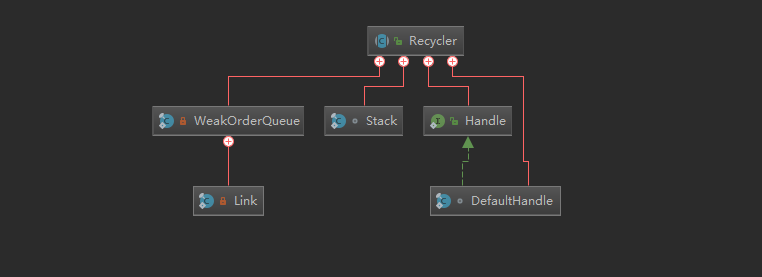
下面再简单介绍下,详细的等遇到就懂了:
- DefaultHandle:保存着对象,对象调用的recycle方法就在此类实现的。
- Stack:就是对象池,里面存放这DefaultHandle数组、WeakOrderQueue链表等信息。
- WeakOrderQueue:当thread2回收thread1的对象时,回收的对象就会暂时放到这里面。
- Link:WeakOrderQueue内部是由一个个Link链表组成的,一个Link默认能存储16个对象。
Recycler的创建及部分属性
先从无参构造看起:
io.netty.util.Recycler#Recycler()
protected Recycler() {
// DEFAULT_MAX_CAPACITY_PER_THREAD默认值为32768
this(DEFAULT_MAX_CAPACITY_PER_THREAD);
}
继续跟进this:
io.netty.util.Recycler#Recycler(int)
protected Recycler(int maxCapacityPerThread) {
//MAX_SHARED_CAPACITY_FACTOR默认值为2
this(maxCapacityPerThread, MAX_SHARED_CAPACITY_FACTOR);
}
继续跟进this:
io.netty.util.Recycler#Recycler(int, int)
protected Recycler(int maxCapacityPerThread, int maxSharedCapacityFactor) {
// RATIO默认值8,用于控制回收频率
// MAX_DELAYED_QUEUES_PER_THREAD默认值跟NioEventLoop一样,等于 cpu核心数*2
this(maxCapacityPerThread, maxSharedCapacityFactor, RATIO, MAX_DELAYED_QUEUES_PER_THREAD);
}
继续跟进this:
io.netty.util.Recycler#Recycler(int, int, int, int)
protected Recycler(int maxCapacityPerThread, int maxSharedCapacityFactor,
int ratio, int maxDelayedQueuesPerThread) {
// 默认值为7
ratioMask = safeFindNextPositivePowerOfTwo(ratio) - 1;
if (maxCapacityPerThread <= 0) {
this.maxCapacityPerThread = 0;
this.maxSharedCapacityFactor = 1;
this.maxDelayedQueuesPerThread = 0;
} else {
this.maxCapacityPerThread = maxCapacityPerThread;
this.maxSharedCapacityFactor = max(1, maxSharedCapacityFactor);
this.maxDelayedQueuesPerThread = max(0, maxDelayedQueuesPerThread);
}
}
再回首这些属性:
// 对象池容量,默认值为32768
private final int maxCapacityPerThread;
// 默认值为2,用于控制当前Recycler能存储多少其它线程的对象
private final int maxSharedCapacityFactor;
// 用于控制回收频率,默认值为7
private final int ratioMask;
// 默认等于 cpu核心数*2 其实是WeakOrderQueue数量
private final int maxDelayedQueuesPerThread;
- 现在不是很清楚含义也不要紧,后面都会遇到。
从Recycler获取对象
跟进Recycler的get方法,此处【坐标1】:
io.netty.util.Recycler#get
public final T get() {
// maxCapacityPerThread意味着不用回收
if (maxCapacityPerThread == 0) {
return newObject((Handle<T>) NOOP_HANDLE);
}
// 获取当前线程的stack
Stack<T> stack = threadLocal.get();
// 从stack中弹出一个对象
DefaultHandle<T> handle = stack.pop();
// 如果对象为空则创建并初始化
if (handle == null) {
handle = stack.newHandle();
// 跳到实验代码的实现中创建对象
handle.value = newObject(handle);
}
// 返回对象
return (T) handle.value;
}
- 如果你不清楚threadLocal.get()、到底做了什么,请参考前言的提到博客。
- newObject就是调用实验代码中覆写的代码。
Stack创建及部分属性
如果FastThreadLocal中没有Stack,那么threadLocal.get()就会构造一个,而Stack构造时的参数也很关键,下面就来看看:
// 每个线程维护一个stack
private final FastThreadLocal<Stack<T>> threadLocal = new FastThreadLocal<Stack<T>>() {
@Override
protected Stack<T> initialValue() {
return new Stack<T>(Recycler.this, Thread.currentThread(), maxCapacityPerThread, maxSharedCapacityFactor,
ratioMask, maxDelayedQueuesPerThread);
}
};
- 后4个参数上面都讲过了。
跟进构造方法,又是一大堆属性:
io.netty.util.Recycler.Stack#Stack
Stack(Recycler<T> parent, Thread thread, int maxCapacity, int maxSharedCapacityFactor,
int ratioMask, int maxDelayedQueues) {
// 保存所属Recycler
this.parent = parent;
// 保存所属线程
this.thread = thread;
// 对象池大小
this.maxCapacity = maxCapacity;
// 当前线程创建的对象有多少是能保存到其它线程的,默认为16,384,LINK_CAPACITY则是16
// 说白了至少是16
availableSharedCapacity = new AtomicInteger(max(maxCapacity / maxSharedCapacityFactor, LINK_CAPACITY));
// 里面就包含了对象,默认初始大小为16,不够会扩容
elements = new DefaultHandle[min(INITIAL_CAPACITY, maxCapacity)];
// 控制回收频率(并不是每次都回收),默认值为7,每8次回收就丢掉一个
this.ratioMask = ratioMask;
// WeakOrderQueue数量
this.maxDelayedQueues = maxDelayedQueues;
}
- 同样,这些属性等下都会遇到,还有些属性等遇到的时候再讲,都很简单。
这里再补充个整体属性图,便于预先了解一些数据结构:
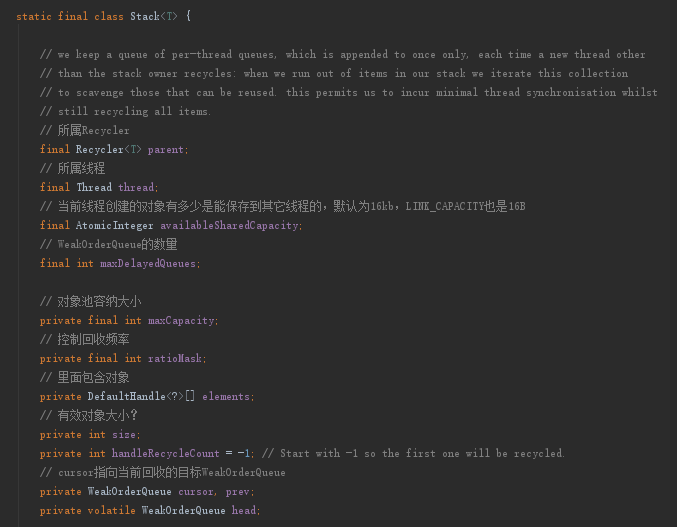
好了,了解完Stack的这些属性,我们可以继续往下走了。
pop弹出对象
pop方法会在没有对象时自动创建,有的话就是从数组里面返回了,还有其它的一些复杂逻辑等铺垫好了再讲。
视角转回【坐标1】的get方法,跟进pop方法:
io.netty.util.Recycler.Stack#pop
@SuppressWarnings({ "unchecked", "rawtypes" })
DefaultHandle<T> pop() {
// 有效对象数量
int size = this.size;
if (size == 0) {
// 对象可能被其它线程回收了,回去把它们捞回来
// 这个方法后面会分析
if (!scavenge()) {
return null;
}
size = this.size;
}
size --;
// 获取到DefaultHandle,里面就存储着对象等
DefaultHandle ret = elements[size];
// 取到有效对象之后将原来的位置置空
elements[size] = null;
if (ret.lastRecycledId != ret.recycleId) {
throw new IllegalStateException("recycled multiple times");
}
// 对象已经被取走了,回收id=0
ret.recycleId = 0;
ret.lastRecycledId = 0;
// 保存对象池有效对象数量
this.size = size;
return ret;
}
- scavenge方法等讲了异线程回收之后再看,暂时放着不影响理解。
以上就是pop获取对象的流程,其实就是根据下标获取到对象,跟喝水一样简单,相信不用我多说了,如果返回null,则在返回到上面的get方法后自动创建。
回收对象到Recycler
比起从Recycler获取对象,将对象回收到Recycler(异线程回收)可就复杂多了。
同线程回收
跟进实验代码的recycle方法:
io.netty.util.Recycler.DefaultHandle#recycle
@Override
public void recycle(Object object) {
if (object != value) {
throw new IllegalArgumentException("object does not belong to handle");
}
// 将对象放入对象池
stack.push(this);
}
跟进push方法,此处【坐标2】:
io.netty.util.Recycler.Stack#push
void push(DefaultHandle<?> item) {
// 取到当前线程
Thread currentThread = Thread.currentThread();
if (thread == currentThread) {
// The current Thread is the thread that belongs to the Stack, we can try to push the object now.
// 同线程回收
pushNow(item);
} else {
// The current Thread is not the one that belongs to the Stack, we need to signal that the push
// happens later.
// 异线程回收
pushLater(item, currentThread);
}
}
- 同线程回收:Thread1产出的Object1,回收的时候也是在Thread1中回收。
- 同线程回收:Thread1产出的Object1,回收的时候是在其它线程中执行。
这里先跟进pushNow方法:
io.netty.util.Recycler.Stack#pushNow
private void pushNow(DefaultHandle<?> item) {
// 若!=0则说明这个对象已经是被回收状态
if ((item.recycleId | item.lastRecycledId) != 0) {
throw new IllegalStateException("recycled already");
}
// 设置回收id,表示对象已被回收了
item.recycleId = item.lastRecycledId = OWN_THREAD_ID;
// 获取有效对象的数量
int size = this.size;
// 已经放不下了 || 检测频率
if (size >= maxCapacity || dropHandle(item)) {
// Hit the maximum capacity or should drop - drop the possibly youngest object.
return;
}
// 扩容
if (size == elements.length) {
elements = Arrays.copyOf(elements, min(size << 1, maxCapacity));
}
// 保存对象
elements[size] = item;
this.size = size + 1;
}
以上就是同线程回收的流程,也很简单,就是保存对象到数组,然后打上各种标记更新各种计数器。
控制频率
其中dropHandle方法就是控制频率,跟进去看看:
io.netty.util.Recycler.Stack#dropHandle
boolean dropHandle(DefaultHandle<?> handle) {
if (!handle.hasBeenRecycled) {
// 频率太高了,不保存对象
// handleRecycleCount 从-1开始,ratioMask = 7,第一个对象回收
// 到后面只有 handleRecycleCount等于8的倍数,8,16才回收,其它都不回收
if ((++handleRecycleCount & ratioMask) != 0) {
// Drop the object.
return true;
}
handle.hasBeenRecycled = true;
}
return false;
}
异线程回收
开始跟进
视角转回到【坐标2】的push方法:
io.netty.util.Recycler.Stack#push
void push(DefaultHandle<?> item) {
// 取到当前线程
Thread currentThread = Thread.currentThread();
if (thread == currentThread) {
// The current Thread is the thread that belongs to the Stack, we can try to push the object now.
// 同一个线程就同步回收
pushNow(item);
} else {
// The current Thread is not the one that belongs to the Stack, we need to signal that the push
// happens later.
// 非当前线程创造的对象则异步回收
pushLater(item, currentThread);
}
}
跟进pushLater方法,此处【坐标3】:
io.netty.util.Recycler.Stack#pushLater
private void pushLater(DefaultHandle<?> item, Thread thread) {
// we don't want to have a ref to the queue as the value in our weak map
// so we null it out; to ensure there are no races with restoring it later
// we impose a memory ordering here (no-op on x86)
// 从DELAYED_RECYCLED(FastThreadLocal)中获取WeakOrderQueue的Map
Map<Stack<?>, WeakOrderQueue> delayedRecycled = DELAYED_RECYCLED.get();
// 根据stack取到WeakOrderQueue
WeakOrderQueue queue = delayedRecycled.get(this);
// queue=null表示当前线程从未回收过其它线程的对象
if (queue == null) {
// 如果当前WeakOrderQueue数量大于最大值
if (delayedRecycled.size() >= maxDelayedQueues) {
// Add a dummy queue so we know we should drop the object
// 打上虚拟标记
delayedRecycled.put(this, WeakOrderQueue.DUMMY);
return;
}
// Check if we already reached the maximum number of delayed queues and if we can allocate at all.
// 创建WeakOrderQueue
if ((queue = WeakOrderQueue.allocate(this, thread)) == null) {
// drop object
return;
}
delayedRecycled.put(this, queue);
} else if (queue == WeakOrderQueue.DUMMY) {
// drop object
return;
}
// 将对象放至队列中
queue.add(item);
}
- DELAYED_RECYCLED.get()实际上就是FastThreadLocal的get方法,不懂的可以参考前言中的博客。
- 异线程回收的对象(Handle)就是存放在WeakOrderQueue的Link中的
先跟进WeakOrderQueue.allocate方法,其中有很重要的概念:
io.netty.util.Recycler.WeakOrderQueue#allocate
static WeakOrderQueue allocate(Stack<?> stack, Thread thread) {
// We allocated a Link so reserve the space
// 判断对象所属stack还能不能分配LINK_CAPACITY内存,能就分配,不能就返回null
return reserveSpace(stack.availableSharedCapacity, LINK_CAPACITY)
? new WeakOrderQueue(stack, thread) : null;
}
继续跟进reserveSpace方法:
io.netty.util.Recycler.WeakOrderQueue#reserveSpace
private static boolean reserveSpace(AtomicInteger availableSharedCapacity, int space) {
assert space >= 0;
for (;;) {
// 获取剩余可用空间
int available = availableSharedCapacity.get();
// 可用空间 < 16
if (available < space) {
return false;
}
if (availableSharedCapacity.compareAndSet(available, available - space)) {
return true;
}
}
}
上面两段代码说明:每次构建一个WeakOrderQueue,都至少保证有LINK_CAPACITY的剩余量,同以前讲到的内存page分配或mysql的page分配,LINK_CAPACITY就是每次申请的最小单位。
WeakOrderQueue构造
我们再来看看WeakOrderQueue的构造:
io.netty.util.Recycler.WeakOrderQueue#WeakOrderQueue(io.netty.util.Recycler.Stack<?>, java.lang.Thread)
private WeakOrderQueue(Stack<?> stack, Thread thread) {
// 一个Link默认大小是16
head = tail = new Link();
owner = new WeakReference<Thread>(thread);
synchronized (stack) {
next = stack.head;
stack.head = this;
}
// Its important that we not store the Stack itself in the WeakOrderQueue as the Stack also is used in
// the WeakHashMap as key. So just store the enclosed AtomicInteger which should allow to have the
// Stack itself GCed.
availableSharedCapacity = stack.availableSharedCapacity;
}
- 下面画出各个类关系结构图后,顺便补上这一块的指针变化。
Link构造
跟进Link的构造方法(整体源码):
private static final class Link extends AtomicInteger {
// 默认一个Link可以存储16个对象
private final DefaultHandle<?>[] elements = new DefaultHandle[LINK_CAPACITY];
private int readIndex;
private Link next;
}
- 可见:Link就是每次向WeakOrderQueue申请空间的最小单位。
- 为什么要这么做呢?因为如果没有Link实现Handle的批量存储,那么再每一次申请存储一个Handle时,都要校验Stack、WeakOrderQueue是否“爆满”了。很浪费性能。而使用Link,则是一次性申请16个Handle,并且只是一次校验,省下了频繁校验的性能损耗。
- 该思想类似于bytebuf的内存申请以及mysql的内存申请。
Stack、WeakOrderQueue、Link的关系与结构
在上面的不同类中,已经遇到不少prev、next、head等指针一样的属性了,但是都没讲到具体数据结构,主要是因为累积还不够多,现在累计足够多的了,直接来看整体会更舒服。
下面就是三者整体的数据结构:
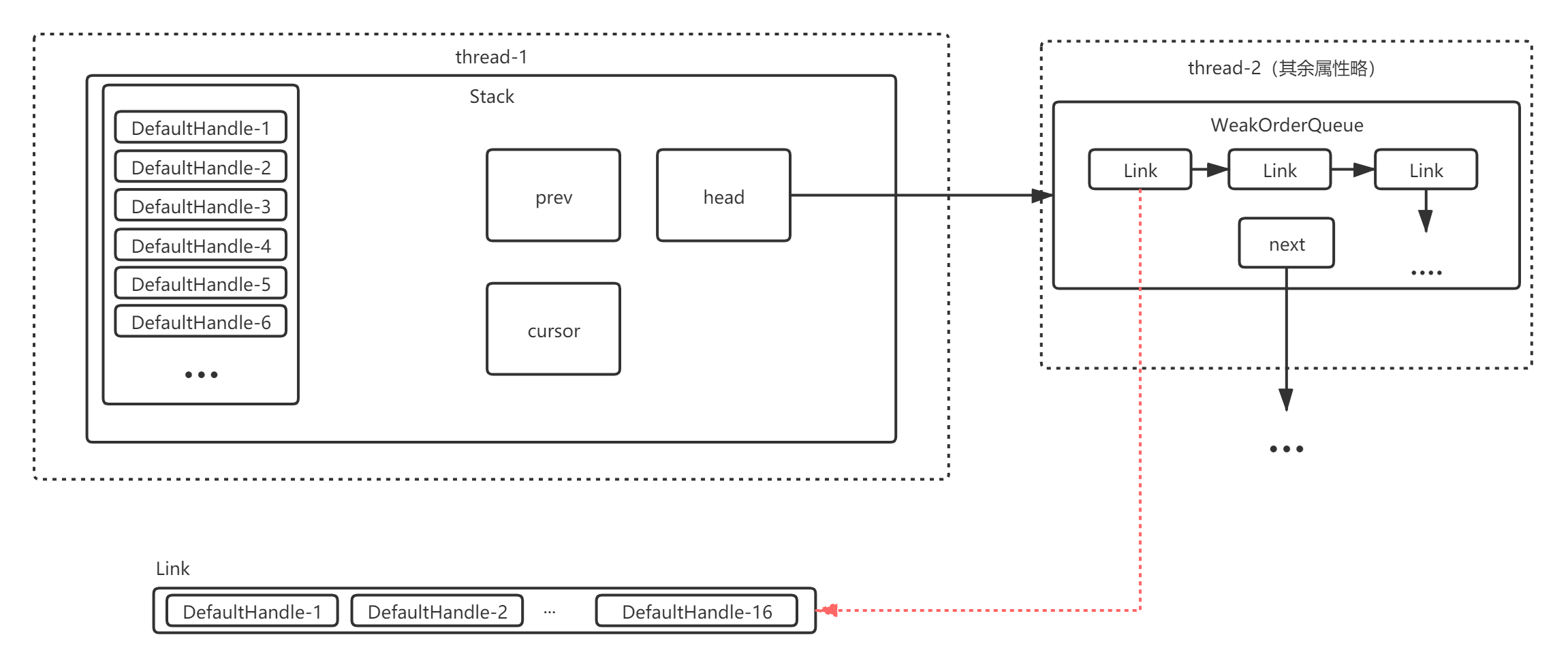
- 当然,为了避免混乱,图中省略了部分指针,如head、tail这种每个节点都有的指针我就省略了。
在了解完结构后,视角转回上面的WeakOrderQueue构造代码。假设现在来了个thread-3,并且它也回收了thread1线程的对象,上面的结构图就会变成下面这个样子:
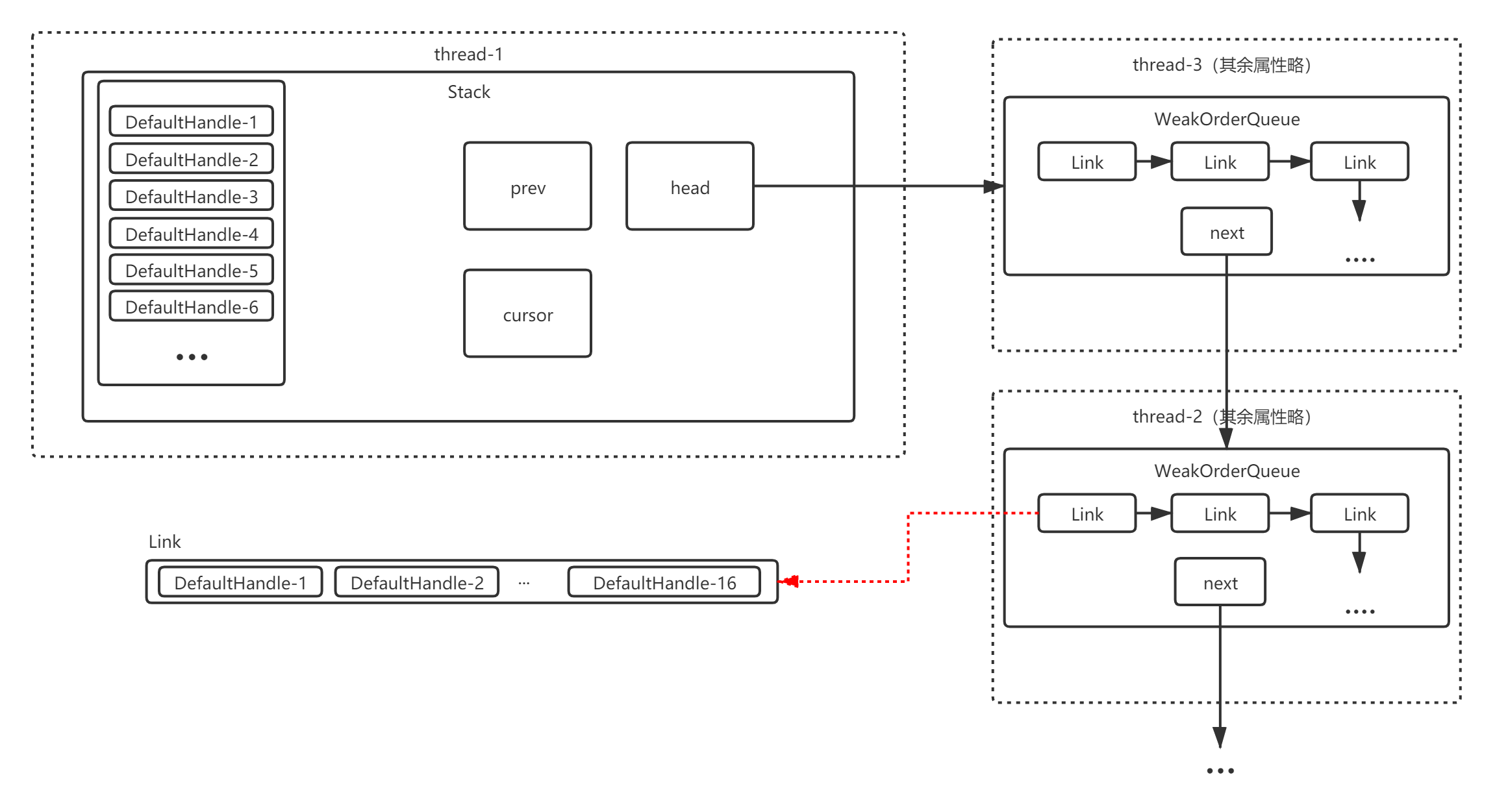
- 说白了,head指向的节点就是最近添加进来的WeakOrderQueue节点。
将对象保存到WeakOrderQueue
在了解了相应的属性和结构之后,将视角转回【坐标3】的pushLater方法,找到如下代码:
io.netty.util.Recycler.Stack#pushLater
queue.add(item);
跟进add方法:
io.netty.util.Recycler.WeakOrderQueue#add
void add(DefaultHandle<?> handle) {
handle.lastRecycledId = id;
Link tail = this.tail;
int writeIndex;
// 如果Link满了
if ((writeIndex = tail.get()) == LINK_CAPACITY) {
// “申请空间”,新建Link
if (!reserveSpace(availableSharedCapacity, LINK_CAPACITY)) {
// Drop it.
return;
}
// We allocate a Link so reserve the space
this.tail = tail = tail.next = new Link();
writeIndex = tail.get();
}
// 对象池存储对象
tail.elements[writeIndex] = handle;
handle.stack = null;
// we lazy set to ensure that setting stack to null appears before we unnull it in the owning thread;
// this also means we guarantee visibility of an element in the queue if we see the index updated
tail.lazySet(writeIndex + 1);
}
- 若Link没满,就往Link的尾部空余空间添加元素,这个过程只是数组赋值,也是跟喝水一样简单,没什么好说的。
- 如果Link满了,则去申请新的Link,并更新tail指针,然后往新的Link中对象赋值。
- reserveSpace()再上面已经看过了,就是向WeakOrderQueue“申请空间”。
好了,现在已经了解到异线程是如何回收对象的了,那么当原线程的Stack取不到Handle时,就会尝试从head节点开始,尝试从异线程的WeakOrderQueue链中把属于自己的对象捞回来,下面来看看这个过程。
从WeakOrderQueue链中捞回对象
视角转移回到上面pop方法,为了方便此处再贴一次代码:
io.netty.util.Recycler.Stack#pop
DefaultHandle<T> pop() {
// 有效对象数量
int size = this.size;
if (size == 0) {
// 对象可能被其它线程回收了,回去把它们捞回来
// 这个方法后面会分析
if (!scavenge()) {
return null;
}
size = this.size;
}
size --;
// 获取到DefaultHandle,里面就存储着对象等
DefaultHandle ret = elements[size];
// 取到有效对象之后将原来的位置置空
elements[size] = null;
if (ret.lastRecycledId != ret.recycleId) {
throw new IllegalStateException("recycled multiple times");
}
// 对象已经被取走了,回收id=0
ret.recycleId = 0;
ret.lastRecycledId = 0;
// 保存对象池有效对象数量
this.size = size;
return ret;
}
其中scavenge方法就是尝试从其它线程捞回对象,跟进这个方法:
io.netty.util.Recycler.Stack#scavenge
boolean scavenge() {
// continue an existing scavenge, if any
if (scavengeSome()) {
return true;
}
// 若没有可捞回对象则重置指针
prev = null;
cursor = head;
return false;
}
继续跟进scavengeSome():
io.netty.util.Recycler.Stack#scavengeSome
boolean scavengeSome() {
// cursor指向当前回收的目标WeakOrderQueue
WeakOrderQueue cursor = this.cursor;
//cursor == null表示其它线程没有回收当前stack产出的对象
if (cursor == null) {
cursor = head;
if (cursor == null) {
return false;
}
}
boolean success = false;
WeakOrderQueue prev = this.prev;
// 根据游标遍历其它WeakOrderQueue循环回收
do {
// 尝试捞回当前stack(this)产出的对象,每次捞回一个Link大小
if (cursor.transfer(this)) {
success = true;
break;
}
WeakOrderQueue next = cursor.next;
// 如果当前 WeakOrderQueue 的线程为null,则说明线程已经不存在了,但WeakOrderQueue对象还在
if (cursor.owner.get() == null) {
// If the thread associated with the queue is gone, unlink it, after
// performing a volatile read to confirm there is no data left to collect.
// We never unlink the first queue, as we don't want to synchronize on updating the head.
// 如果此 WeakOrderQueue 还有数据,则尝试捞回这些对象
if (cursor.hasFinalData()) {
for (;;) {
if (cursor.transfer(this)) {
success = true;
} else {
break;
}
}
}
if (prev != null) {
// cursor、prev、next都是指向WeakOrderQueue
// 下面代码就是释放cursor
/*
* prev(thread-4) -> cursor(killed) -> next(thread-2)-> ...
*
* prev(thread-4) -> next(thread-2)-> ...
*/
prev.next = next;
}
} else {
prev = cursor;
}
cursor = next;
} while (cursor != null && !success);
this.prev = prev;
this.cursor = cursor;
return success;
}
最后跟进transfer方法,我们就能看见是如何捞回对象的了(每次只捞回一个Link,捞回多少个由指针决定):
io.netty.util.Recycler.WeakOrderQueue#transfer
boolean transfer(Stack<?> dst) {
Link head = this.head;
if (head == null) {
return false;
}
// 如果Link满了
if (head.readIndex == LINK_CAPACITY) {
// 如果没有下一个Link了
if (head.next == null) {
return false;
}
// 指向下一个Link
this.head = head = head.next;
}
// 获取开始坐标readIndex
final int srcStart = head.readIndex;
// 获取Link一共有多少个对象
int srcEnd = head.get();
// 可以捞回的对象总数
final int srcSize = srcEnd - srcStart;
if (srcSize == 0) {
return false;
}
final int dstSize = dst.size;
// 把对象捞回来之后占用的大小
final int expectedCapacity = dstSize + srcSize;
// 如果大小不够
if (expectedCapacity > dst.elements.length) {
// 扩容
final int actualCapacity = dst.increaseCapacity(expectedCapacity);
srcEnd = min(srcStart + actualCapacity - dstSize, srcEnd);
}
if (srcStart != srcEnd) {
final DefaultHandle[] srcElems = head.elements;
final DefaultHandle[] dstElems = dst.elements;
int newDstSize = dstSize;
// 遍历Link的数组元素到当前stack
for (int i = srcStart; i < srcEnd; i++) {
DefaultHandle element = srcElems[i];
if (element.recycleId == 0) {
element.recycleId = element.lastRecycledId;
} else if (element.recycleId != element.lastRecycledId) {
throw new IllegalStateException("recycled already");
}
srcElems[i] = null;
// 控制频率,前面讲过
if (dst.dropHandle(element)) {
// Drop the object.
continue;
}
element.stack = dst;
dstElems[newDstSize ++] = element;
}
// 当前Link回收完了,且后面还有Link
if (srcEnd == LINK_CAPACITY && head.next != null) {
// Add capacity back as the Link is GCed.
// 说明当前Link已经空了,释放剩余容量
reclaimSpace(LINK_CAPACITY);
// 指向下一个Link
this.head = head.next;
}
head.readIndex = srcEnd;
// 说明没有上面的for循环被跳过了,即没有传输任何对象
if (dst.size == newDstSize) {
return false;
}
// 更新stack中有效对象数量
dst.size = newDstSize;
return true;
} else {
// The destination stack is full already.
return false;
}
}
- 上面的for循环就是将Link中的元素一个个拉回到Stack的DefaultHandle数组。
Link变化如下图:
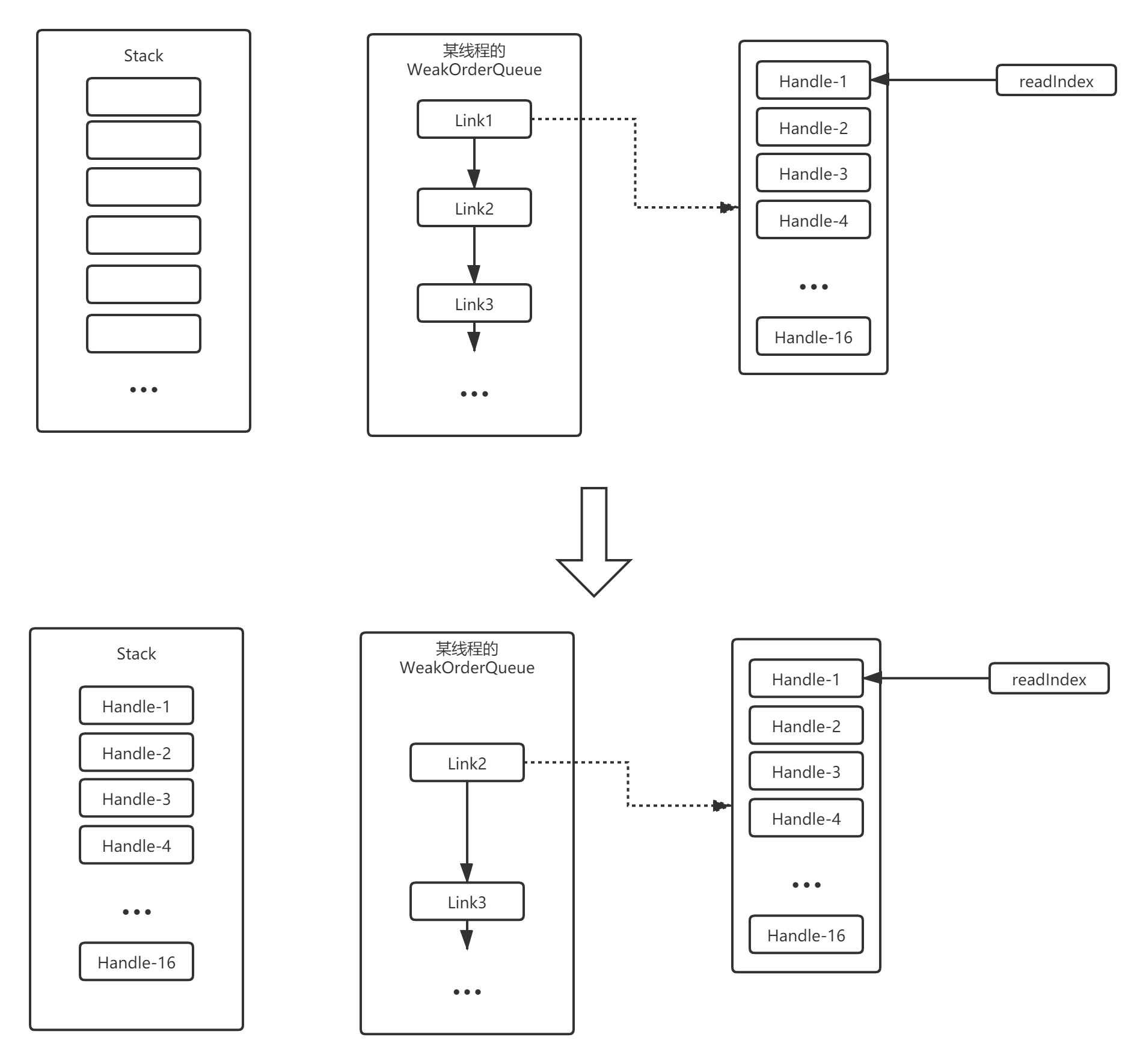
好了,常用的api暂时就分析到这。
可能需要注意的点
- Recycler在构建/获取Stack的时候,使用的是FastThreadLocal,而在上一篇博客分析FastThreadLocal的时候,有一条很重要的规则:要使用FastThreadLocal,必须保证线程类型是FastThreadLocalThread。
- 这条规则意味着:我们在使用Recycler的时候,也应该尽量保证线程类型为FastThreadLocalThread,这样就能间接的优化Recycler获取Stack的时间复杂度。